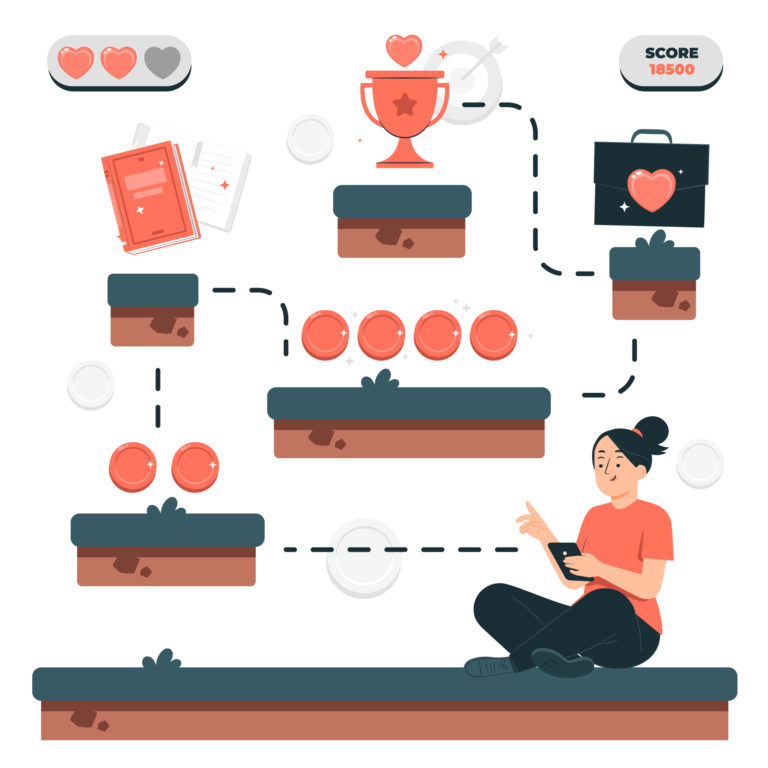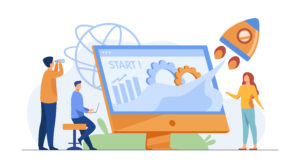App Gamification: Increasing Engagement
The universe of app gamification is like stepping through a portal into a world where user engagement transforms from the ordinary to the extraordinary. 🎮 Picture this: a journey where the main goal is to lure users into a captivating experience. In a landscape where apps engage in an attention-grabbing tug-of-war, gamification steps into the arena as the ultimate secret weapon for keeping users hooked.🌟It’s not just about making an app; it’s about creating an immersive adventure that users can’t resist.

- 23 November, 2023

The universe of app gamification is like stepping through a portal into a world where user engagement transforms from the ordinary to the extraordinary. 🎮 Picture this: a journey where the main goal is to lure users into a captivating experience. In a landscape where apps engage in an attention-grabbing tug-of-war, gamification steps into the arena as the ultimate secret weapon for keeping users hooked.🌟It’s not just about making an app; it’s about creating an immersive adventure that users can’t resist.
🎲 What is Gamification?
App gamification involves the integration of game-like elements into non-game applications, adding a layer of fun features to enhance user engagement. This strategy aims to make the user experience more enjoyable and interactive.
It’s a way to keep users interested, focused on their goals, and improve important things like how many people stick around (retention rate), how often they use the app (sessions), and the overall experience.
🎯 Why Gamify?
Gamification is crucial for retaining and engaging users in the competitive app landscape. Gamified apps use basic psychology to make users feel accomplished and motivated to keep using the app.
By tapping into fundamental human motivations, such as the desire for achievement, competition, and community, apps can create a compelling environment that encourages users to return regularly. Some case studies claim that using gamification wisely can boost mobile user engagement by 47%.
🎮Key Elements for Successful Gamification
In the realm of app gamification, various elements are used to make non-game apps more enjoyable for users. And the best thing is that you don’t have to overhaul your whole app to add gamification. You can just build it as an extra feature.
Let’s check some most commonly used gamification elements:
🔢 Points: quantify user activity or achievement, giving a clear way to see their progress and engagement.
🏅 Badges: visually recognize users’ milestones and accomplishments, providing a sense of achievement.
📊 Leaderboards: introduce competition by displaying user rankings based on different criteria, fostering a dynamic and engaging environment.
🎯 Challenges: present users with specific tasks or goals, offering a structured and rewarding way to interact with the app.
🎁 Rewards: serve as incentives for user engagement and achievement, motivating continued app usage.
🔍 Quests: provide a narrative structure, guiding users through tasks or challenges and adding depth to the user experience.
These parts work together to make users feel accomplished, create friendly competition, and build a virtual community in apps that aren’t games. When these features are added carefully, apps can make a lively and interesting environment that grabs users’ attention and makes them want to stay engaged for a long time.
💡Perks of Gamification
Enhanced Engagement: Gamification elevates user engagement, making interactions more compelling and enjoyable.
Increased Retention: By incorporating game elements, apps encourage users to stay connected over time, reducing churn.
Satisfaction Boost: Users experience a heightened sense of satisfaction when they accomplish tasks and get rewards.
Behavioral Drive: Gamification stimulates desired user behaviors, encouraging users to engage more with the app, share it with friends, and complete tasks.
Memorable Experience: The competitive and rewarding aspects contribute to a memorable and positive overall user experience.
🌟Gamification Delights: Inspiring Examples!
Duolingo (Language Learning): its gamified lessons make learning fun and interactive with points, levels, and achievements, motivating consistent user engagement.
Nike Training Club (Fitness): it offers personalized workouts, achievements, and challenges, fostering a sense of accomplishment and motivation for users.
Starbucks Rewards (Loyalty): it excels in gamifying loyalty through a point-based system, unlocking perks and offers, encouraging frequent visits and brand loyalty.
💪How to Do It Effectively?
Tip #1. Promote competition and sociability
Incorporate an in-app community with challenges, points, and leaderboards.
Tip #2. Visualize progress
Use achievements, progress bars, and leveling systems to illustrate user growth.
Tip #3. Encourage participation
Reduce user churn by awarding points, badges, and prizes.
Tip #4. Clarify winning
Use a basic digital confetti graphic for visualizing a user’s success, offer timely positive feedback to make rewards more effective.
🌈Wrapping Up the Adventure!
Gamification adds a fun and rewarding twist to various areas. In fitness apps, it motivates users to stay active by turning exercise into a rewarding challenge. Health and wellness apps use gamification to encourage healthy habits and track progress. Even in customer loyalty programs and marketing, gamified elements enhance user participation and brand interaction. Across diverse sectors, gamification proves to be a versatile and effective strategy for making experiences more enjoyable, engaging, and goal-driven.
Related Posts

How to Craft Your Startup’s Business Plan?

Turn The Idea into Million-Dollar Startup

MVP: Why It’s Crucial for Startup Success?
Have a project you would like to talk about?
info@codegeeks.solutions
108 Stryjska St, Lviv, Ukraine
+38 (093) 234 34 76







